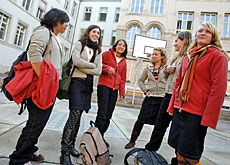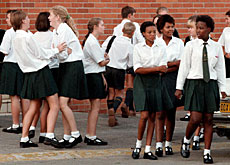Pupils slip into something more controversial

Forty secondary school pupils in Basel started classes in uniforms on Tuesday, in the first ever project of its kind in Switzerland.
The six-month pilot programme aims to measure how much a school uniform affects teaching, the pupil’s identity and spending habits, but the idea has already met solid resistance and been branded as “unSwiss”.
In all, two classes of 14- to 15-year-olds at the state-run Leonhard school turned up in the smart-casual uniform, although the school itself prefers to talk of “school clothing”.
Until now there has been no tradition of wearing school uniforms in Switzerland.
At the end of the trial period, project organisers, school administrators and budgeting specialists will analyse the pros and cons.
Also giving their views in six months time will be scientists at the Institute of Psychology in Basel, pupils, teachers and parents. A decision will then be taken whether to extend and expand the project.
Organisers hope uniforms will eventually be introduced from Kindergarten age across the canton. For that to happen, however, a revision of the law would be necessary.
Intelligent design?
The uniform, by Basel designer Tanja Klein, comprises a total of 14 items which can be freely combined.
The final collection was chosen by a jury, which included pupils, and is said to have a modern, young look. However, it is a far cry from what most people – especially from other countries where uniforms are extremely common – consider to be a school uniform, namely dark trousers or skirt, white shirt, tie and blazer.
Klein’s designs include trainers, three-quarter length cargo pants, hoods and beanie hats.
Although a full set costs around SFr730 ($575), it has been estimated that wearing a school uniform saves 30 per cent on clothing expenses.
Parents of pupils in the project only have to chip in a small amount. The bulk of the cost is being shouldered by sponsors.
Scepticism
However, there is much scepticism about uniforms in Switzerland.
The parliaments in the cantons of Zurich and Solothurn have previously spoken out against uniforms and in February Lucerne cantonal parliament rejected a similar proposal by the rightwing Swiss People’s Party.
The idea was thrown out on the grounds that school uniforms didn’t suit the cultural environment and suppressed the identity and personality of the child.
Josef Roos, the People’s Party parliamentarian who proposed the motion, argued that the move was necessary to tackle school children being to concerned with fashion clothing.
For Roos, uniforms work in favour of a classless society. “With everyone dressed the same, you can no longer tell if a child comes from a lawyer’s or factory worker’s family,” he said.
Not everyone agrees. “School uniforms are unSwiss,” said Damian Meier, a cantonal parliamentarian from the centre-right Radical Party.
When the Basler Zeitung newspaper started an internet forum on the issue earlier in the year, one contributor said: “The idea is well-intentioned but I have… some difficulty with school uniforms. It has something to do with the army, with the ‘we’ feeling of the National Socialist past.”
swissinfo with agencies
At the end of January, the cantonal government in Lucerne voted against the introduction of school uniforms.
As a general rule, school children in Switzerland do not wear uniforms.
School uniforms dominate in Britain, Ireland and Cyprus. Outside Europe they are the norm in Australia, New Zealand, South Africa, Japan and many former British colonies.
The acceptability or otherwise of school uniforms appears to largely be a reflection of national culture and tradition.
Thus in Britain, Japan, Singapore, Malaysia, Australia, Fiji and New Zealand uniforms are seen as a form of working dress which is rarely challenged by either the wearers or society.
In the United States and many West European countries school uniforms are more often perceived as symbols of a restrictive culture that has no place in the educational process.

In compliance with the JTI standards
More: SWI swissinfo.ch certified by the Journalism Trust Initiative

You can find an overview of ongoing debates with our journalists here. Please join us!
If you want to start a conversation about a topic raised in this article or want to report factual errors, email us at english@swissinfo.ch.